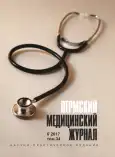Antioxidant status of patients with atherothrombotic variant of ischemic stroke
- Authors: Shestakov V.V.1, Selezneva S.I.1, Sosnin D.Y.1
-
Affiliations:
- Academician Ye.A. Vagner Perm State Medical University
- Issue: Vol 34, No 6 (2017)
- Pages: 22-28
- Section: Articles
- URL: https://journals.rcsi.science/PMJ/article/view/7892
- DOI: https://doi.org/10.17816/pmj34622-28
- ID: 7892
Cite item
Full Text
Abstract
Aim. To study the dependence of antioxidant status (AOS) on the age, sex, localization and size of the damage focus in patients during the most acute period of the development of atherothrombotic variant of ischemic stroke.
Materials and methods. Seventy four patients (main group) in the most acute period of atherothrombotic variant of ischemic stroke were examined. The group of comparison, comparable by age and sex, included 15 healthy persons. The total blood serum antioxidant status was investigated using an assay kit of “Vector-Best” Company B-7501 (“Vector-Best”, Russia).
Results. AOS value in the comparison group was 1,69 ± 0,17 mmol/l (median 1,72; interquartile range 1,53-1,83 mmol/l) that corresponded to the standard interval, indicated in the assay kit guidelines (1,3-1,8 mmol/l). OAS did not differ in men and women (criterion U = 26,0; p = 0,816). In patients of the main group, AOS was reduced ( p = 0,000034); AOS value was 1,14 ± 0,4 mmol/l (median 1,12 mmol/l, interquartile range 0,81-1,45 mmol/l). Age, sex and localization of stroke focus did not reliably influence the degree of AOS fall. Moderate reverse correlation between the focal sizes and decreased AOS value was established. Spearman’s rank correlation coefficient was -0,79 ( p < 0,001).
Conclusions. Decrease in AOS during the most acute period of developing atherothrombotic stroke does not depend on sex, age, ischemic focus localization, but it depends on sizes of the focus, subjected to ischemization.
Keywords
Full Text
##article.viewOnOriginalSite##About the authors
V. V. Shestakov
Academician Ye.A. Vagner Perm State Medical University
Author for correspondence.
Email: sosnin_dm@mail.ru
доктор медицинских наук, профессор, заведующий кафедрой неврологии с курсом нейрореабилитологии ФДПО
Russian Federation, PermS. I. Selezneva
Academician Ye.A. Vagner Perm State Medical University
Email: sosnin_dm@mail.ru
аспирант кафедры неврологии с курсом нейрореабилитологии ФДПО
Russian Federation, PermD. Yu. Sosnin
Academician Ye.A. Vagner Perm State Medical University
Email: sosnin_dm@mail.ru
доктор медицинских наук, доцент кафедры клинической лабораторной диагностики ФДПО
Russian Federation, PermReferences
- Кравцова Е.Ю., Мартынова Г.А., Кравцов Ю.И., Соснин Д.Ю. Окислительная модификация белков в остром периоде ишемического инсульта. Журнал неврологии и психиатрии 2014; 114(8-2): 32-33.
- Кравцов Ю.И., Кравцова Е.Ю., Селезнева С.И., Соснин Д.Ю. Антиоксидантный статус крови у больных с патогенетическими подтипами ишемического инсульта. Журнал неврологии и психиатрии 2014; 117(8-2): 37-42.
- Кулеш А.А. Шестаков В.В., Сыромятникова Л.И., Кравцова Е.Ю., Боков К.Н., Дементьева О.В., Селезнева С.И. Характеристика ишемического инсульта по данным госпитального регистра: место нейрорепаративной терапии. Журнал неврологии и психиатрии им. С.С. Корсакова 2015; 115(7): 56-60.
- Румянцева С.А., Силина Е.В., Чичановская Л.В., Назаров М.В., Цукурова Л.А., Коваленко А.Л., Кабаева Е.Н., Ступин В.А. Эффективность антиоксидантной энергокоррекции при инфаркте головного мозга (результаты многоцентрового рандоминизированного исследования). Журнал неврологии и психиатрии имени С. С. Корсакова. 2014; 114 (10-1): 49-55.
- Chiquete E., Ruiz-Sandoval J.L., Murillo-Bonilla L.M., Arauz A., Orozco-Valera D.R., Ochoa-Guzmán A., Villarreal-Careaga J., León-Jiménez C., Barinagarrementeria F., Ramos-Moreno A., Cantú-Brito C. Serum Uric acid and outcome after acute ischemic stroke: PREMIER Study. Cerebrovasc Dis 2013; 35: 168-174.
- George P.M., Steinberg G.K. Novel stroke therapeutics: unraveling stroke pathophysiology and its impact on clinical treatments. Neuron 2015; 87 (2): 297-309.
- Içme F., Erel O., Avci A., Satar S., Gülen M., Acehan S. The relation between oxidative stress parameters, ischemic stroke, and hemorrhagic stroke. Turkish journal of medical sciences. 2015; 45 (4): 947-953.
- Khanna S., Heigel M., Weist J., Gnyawali S., Teplitsky S., Roy S., Sen CK., Rink C. Excessive α-tocopherol exacerbates microglial activation and brain injury caused by acute ischemic stroke. FASEB journal. 2015; 29(3): 828-836.
- Lee J.C., Won M.H. Neuroprotection of antioxidant enzymes against transient global cerebral ischemia in gerbils. Anatomy & cell biology. 2014; 47(3): 149-156.
- Leionen J.S., Ahonen J.P., Lönnrot K., Jehkonen M., Dastidar P., Molnar G., Alho H. Low plasma antioxidant activity is associated with high lesion volume and neurological impairment in stroke. Stroke. 2000; 31(1): 33-39.
- Miao Y., Liao J.K. Potential serum bio-markers in the pathophysiological processes of stroke. Expert review of neurotherapeutics 2014; 14(2): 173-185.
- Mohsin M., Das S.N., Haque M.F., Shikha S.S., Bhuiyan A.S., Saha P.L., Das B.R., Chowdhury M., Jahan M.K., Rahman M.M. Serum uric acid level among acute stroke patients. Mymensingh medical journal 2016; 25(2): 215-220.
- Reis Cesar, Akyol Onat, Ho Wing Mann, Araujo Camila Huang, Lei, Applegate Richard, Zhang John H. Phase I and Phase II Therapies for acute ischemic stroke: an update on currently studied drugs in clinical research. Biomed Res Int. 2017; available at: https://www.ncbi.nlm.nih.gov/pmc/ articles/PMC5329656/pdf/BMRI2017-4863079.pdf
Supplementary files






